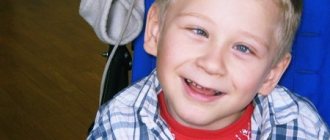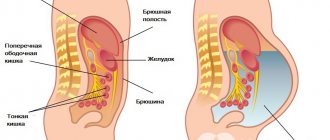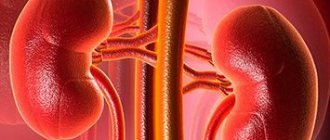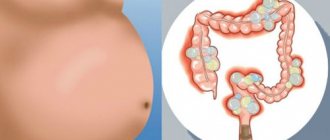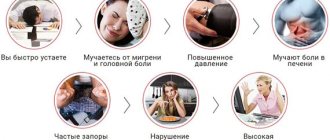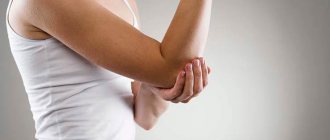The thoracic spine is characterized by a natural bend at an angle of no more than 30 degrees. When this angle begins to increase, kyphosis develops. In the early stages, the disorder may not bother the person. Subsequently, pathological processes affect the chest organs and lead to visible posture disorders. The development of kyphosis can be prevented or cured using conservative methods.
What causes and degrees of kyphosis exist, how to treat this disorder at home, you will learn from this article.
- Physiotherapy
Basic information, reasons, degrees
Kyphosis is understood as a pathological change in the shape of the spinal column in the anteroposterior direction. If the bending angle does not exceed 30°, then we are talking about physiological convexity. If this indicator is higher, then doctors diagnose “kyphosis”.
Important. Kyphosis of 1st - 2nd degree has a mild course, so the patient may not notice the symptoms. At stages 3–4, the pathology manifests itself with pronounced symptoms, but it is much more difficult to cure, and in some cases impossible.
In the early stages of the disease, stooping appears, and later the outline of a hump appears.
Degrees of kyphosis:
- 1st degree – the bending angle exceeds 40°.
- 2nd degree – from 40 to 50°.
- 3rd degree – from 50 to 70°.
- 4th degree – more than 70°.
Each stage of the disease has its own characteristics and requires an individual approach to treatment.
Most often, doctors diagnose curvature of the thoracic spine. However, pathology can affect the cervical and lumbar segments.
You can read more about kyphosis of the thoracic segment in this article.
Reference. Kyphosis and scoliosis can develop simultaneously. Then a combined deformation of the spine is observed: forward-backward and lateral bending. In the early stages, kyphoscoliosis is treated with conservative methods; in case of pronounced changes, surgery is performed.
There are many types of kyphosis (depending on location, origin, shape, etc.), which you can learn about here.
Orthopedists identify the following causes of pathology:
How many curves does the human spine have?
- Intrauterine anomalies of the spine.
- Staying in an incorrect position for a long time, which causes poor posture.
- Hereditary predisposition.
- Spinal injuries.
- Polio.
- Tuberculosis of bones.
- Rickets.
- Osteoporosis.
- Muscular dystrophy.
- Diseases accompanied by degenerative disorders of the vertebrae or discs between them.
- Ankylosing spondylitis.
- Osteochondrosis.
- Arthritis.
- A pathology in which bone growths (osteophytes) appear on the vertebral bodies.
The likelihood of kyphotic curvature increases with excessive physical activity, excess weight, and after unsuccessful spinal surgery.
Reference. The rate at which kyphosis progresses depends on the cause of its occurrence. The pathology is especially dangerous for adolescent children, as it develops quickly during a period of intensive growth.
Classification of kyphosis
There are several criteria by which kyphosis is classified. This is a definition of types in terms of degrees of formation, location of the apex of the bend along the entire length of the spine, and time of appearance.
Types by time of appearance:
- kyphosis of infancy;
- teenage form;
- kyphosis in adulthood;
- senile kyphosis.
Types by summit location:
- kyphosis of the cervical spine;
- upper thoracic region;
- in the region of the heart;
- in the lower part of the thoracic region;
- on the periphery of the chest and lower back;
- in the lumbar spine.
The most common form of the disease is thoracic curvature. Primarily because poor posture as a result of incorrect body position, osteochondrosis and age-related changes that cause deformation of the sternum area are common to a large number of people.
Manifestations of 1st – 2nd degree curvature
Kyphosis of the 1st degree has a mild course, so most often patients do not even notice any changes in their condition. The only signs are discomfort in the affected area (usually the chest) and stiffness of movement. Visually, the pathology is also impossible to detect, and x-rays show a normal bending angle (from 31 to 40°). To identify disorders, it is necessary to conduct a more thorough diagnosis, which neither patients nor doctors usually see the need for.
Kyphosis 2 degrees manifests itself with a C-shaped back
Kyphosis of the 2nd degree can be noticed during visual examination. A pronounced stoop appears, the shoulders drop slightly forward. The bending angle is in the range of 41 - 50°.
At this stage the following symptoms appear:
- Pain in the affected area.
- Feeling of tightness, pressure.
- Quick fatigue when staying in one position for a long time.
- The patient unconsciously slouches to relieve discomfort.
- The muscles of the upper and lower extremities are weakened.
Reference. At stage 2 of kyphosis, there is a risk of compression of the nerve roots by displaced vertebrae. Then the sensitivity of those parts of the body for which the damaged nerve endings are responsible is impaired.
To identify pathology in a child, you need to carefully monitor his posture. When he sits at the table, his back bends and resembles the letter C. He quickly gets tired when in one position, discomfort appears, which he tries to get rid of by changing the position of his back.
Pathology of the 2nd degree is easiest to identify and can be treated with a conservative method. Without treatment, the disease progresses, affecting other areas of the spinal column. And this threatens with dangerous complications and developmental delays in children.
At stage 2, the intervertebral discs and the cartilage pads between them begin to deteriorate. Then the mobility of the affected segment of the spine is limited, the muscles around it are strained and stretched. At this stage, shortness of breath, cephalalgia (headache), and dizziness may appear. The likelihood of dysfunction of the respiratory organs, heart, and digestive tract increases.
Reasons for the development of the disease
There may be several reasons for the development of kyphosis, but most often it is acquired. Let's look at the main reasons.
Congenital pathologies in the development of the musculoskeletal system
A common cause is congenital pathologies in the development of the musculoskeletal system. Kyphosis is observed in patients with cerebral palsy. May manifest as a birth injury.
Various diseases, such as rickets, tuberculosis
Rickets and tuberculosis, coupled with a general weakening of the body, negatively affect the spine. Lack of vitamin D in such diseases has a destructive effect on bone tissue, weakening it and causing deformation.
Improperly organized workplace
Very often, smoothed thoracic kyphosis occurs in women and men who lead a sedentary lifestyle. Office work with an improperly organized workplace is one of the main causes of acquired kyphosis.
Inflammatory processes in the body
Inflammatory processes, such as spinal hernia, often cause kyphosis. The pressure of the hernia on the vertebrae distorts the natural healthy curve of the spine.
Symptoms in grade 3
With third-degree pathology, doubts about the presence of kyphosis no longer arise. There is a pronounced stoop, the curvature is more like a hump. The shoulders move forward, tilt down slightly, the chest becomes sunken, and the stomach protrudes slightly. The angle of curvature ranges from 51 to 70°.
With grade 3 kyphosis, a large hump appears on the back
In addition to the external manifestations of the disease, neurological disorders are observed. This is due to the fact that at this stage the displaced vertebrae compress the nerve bundles, therefore the functionality of various organs is disrupted. The volume of the chest decreases, which negatively affects the functioning of the lungs.
Kyphosis of the 3rd degree is manifested by the following symptoms:
- Weakness of the upper limbs.
- Loss of sensitivity in the affected area of the back.
- Severe pain syndrome.
- Breathing disorders with minor exertion.
- Heartbeat disturbance.
Deformed vertebrae put pressure on the blood vessels, then its blood supply is disrupted, and oxygen starvation occurs. This condition is accompanied by the following symptoms:
- Hypertension.
- Frequent headaches.
- Impaired movement coordination.
- Vision disorders.
- Lack of control over the process of urination and defecation.
- Paralysis of the lower body.
In case of stage 4 disease, the angle of curvature exceeds 70°. A large hump appears on the back, and the abdominal muscles are constantly relaxed. At this stage, nerve bundles are often pinched, which disrupts the functionality of various organs and causes problems with movement. The patient suffers from many complications and urgent surgery is necessary.
Prevention
Of course, it is always better to prevent a disease by preventing it and supporting your body, rather than fighting it at later stages. To prevent kyphosis, follow a number of simple recommendations:
- It is important to lead an active and mobile lifestyle.
- Even from school, you need to teach yourself and your children to sit up straight and not slouch.
- Play sports or at least do daily exercise. Exercises for kyphosis and to prevent it involve bending, stretching, and hanging on a horizontal bar is very useful.
- If you are constantly sedentary, it is important to take periodic breaks to stretch or walk.
- If you experience discomfort, strain, or noticeable stoop in your back, you can undergo preventive massage therapy.
Otherwise, regarding the treatment and prevention of kyphosis, you should definitely contact a specialized specialist. In addition, with this disease, you cannot put off going to the doctor, because the sooner you deal with the problem, the easier the treatment will be and the less harm will be done to your health.
(
2 ratings, average: 5.00 out of 5)
Diagnostic measures
If you suspect kyphosis, you should contact an orthopedist, traumatologist or surgeon. The doctor conducts a survey, finds out about the symptoms present, and palpates the back and neck. Using functional tests, the specialist determines the neurological status of the patient. Visual examination is supplemented by instrumental studies:
- X-ray in frontal and lateral projection. The Cobb method will help to assess the degree of curvature. To do this, dots are placed on the x-ray (lateral projection) in the center of the spine at the apex of the curve and the vertebrae at the edges. Then they are connected by lines into a triangle and the sides are extended. The resulting angle is an indicator of the degree of curvature.
- Magnetic resonance imaging and computed tomography are highly informative diagnostic methods that will help identify even minimal disturbances in the structure of bones, cartilage and surrounding tissues, and accurately determine the affected area.
Reference. CT and MRI are used before surgery or to identify pathological processes that caused kyphosis.
If there are concomitant diseases, the patient may be prescribed an ultrasound of the abdominal organs, ECG, spirography, X-ray of the lungs, gastroscopy, radioisotope study (a diagnostic method using radiopharmaceuticals).
To assess the general condition of the patient, laboratory diagnostics are performed:
- Clinical analysis of blood and urine.
- Biochemistry of blood.
- Tests for HIV, hepatitis, syphilis.
- Coagulation tests (assessment of blood clotting), etc.
These tests will help identify internal disorders and infectious diseases.
It is very rare to detect stage 1 disease, in contrast to stage 2 pathology, which is manifested by pronounced changes.
Diagnostics
Of course, in order to resist the disease, it is preferable to detect it in the initial stages of development; for this, the diagnosis of the disease should be carried out by an experienced doctor. Diagnostic measures are as follows:
- Primary examination, including examination of the patient, palpation, and medical history.
- Functional diagnostics, which involves performing a series of bending exercises to detect and assess the degree of deviations.
- X-ray of the spine to identify structural abnormalities.
- or MRI to obtain more detailed information and evaluate the condition of the vessels.
- If necessary, an ultrasound examination of the intervertebral discs is performed.
How to independently identify thoracic kyphosis?
To independently identify the disease in the early stages of its development, that is, before the curvature is obvious and noticeable to the naked eye, 2 simple tests are used:
- Lean your back against the wall, standing straight so that your heels touch it. Now touch the back of your head to the wall; with kyphosis, this will cause difficulties or will not work at all.
- Stand with your side to the mirror, lean down and straighten your back. With the development of pathology, the violation will be visible to the naked eye; it represents a curvature in a certain area.
Consequences of kyphosis 1 - 2 degrees
If left untreated, the first stage of kyphosis progresses to the second. If the pathology progresses rapidly, the risk of respiratory disorders and disruption of the cardiovascular and digestive systems increases. Patients often complain of pain in the affected area and in the interscapular area.
Dangerous complications of the second stage of kyphosis:
- Paralysis of limbs.
- Impaired control of the urinary process.
- Functional disorders of internal organs.
- Herniated intervertebral discs.
- Inflammation of the membranes of the brain or spinal cord.
- Loss of ability to work.
- Coronary heart disease, including heart attack.
To avoid these dangerous complications, it is important to start treatment as early as possible.
Complications
With the progression of kyphosis, problems in the functioning of the lungs, heart, and gastrointestinal tract first begin. As a result of thoracic kyphosis, hypoxia, arrhythmia, asthma, pneumonia, pleurisy, gastritis, liver, gallbladder and kidney diseases develop. Kyphosis of the cervical spine is accompanied by hypertension, neuralgia, sinusitis, eczema, goiter, sore throat, and pharyngitis. Less common is lumbar kyphosis, which can provoke diseases such as arthrosis, radiculitis, sciatica (inflammation of the sciatic nerve), cystitis, and edema. A dangerous outcome of untreated kyphosis is intervertebral hernia, secondary meningitis, paralysis and paresis, and possible disability.
Methods of treating the initial stages of pathology
When treating 1st degree curvature, the following methods are used:
- Physiotherapy.
- Physiotherapeutic methods.
- Moderate physical activity, avoiding excessive exercise.
- Proper nutrition.
- Use of orthopedic devices.
- Posture correction.
A corset for kyphosis will help correct minor curvature
To correct the deformity, special corsets are used. They relieve the spine and keep it in the correct position. You need to choose a device that is exactly the right size. However, it is not recommended to wear a corset all the time, otherwise the muscles around the affected area weaken, and then it is difficult for them to support the spine. The optimal wearing time is 20 hours per day, but gradually this time needs to be reduced.
Exercise therapy will help strengthen the muscular corset, as well as the muscles of the upper back, and correct curvature at an early stage. In addition, gymnastics improves metabolic processes and stimulates blood flow. It is recommended to train daily for 30–40 minutes. Only with regular exercise will you be able to achieve positive dynamics. The exercise program is drawn up by the doctor for each patient separately.
Complex treatment can be supplemented with massage and manual therapy. The main thing is to find a qualified specialist. These procedures are effective in the early stages of the disease; they will help correct posture, restore muscle tone, realign displaced vertebrae and discs between them, and normalize blood flow.
The patient must also follow a diet. It is important to replenish your diet with food rich in proteins, complex carbohydrates, fiber, vegetable fats, vitamins, and minerals. Proper nutrition will help improve metabolic processes and the general condition of the body, saturate it with useful substances.
In the early stages of the disease, physiotherapeutic procedures are used:
- Magnetotherapy.
- Ultrasound treatment.
- Electrophoresis.
- Heat therapy.
- Electrical stimulation.
- Mud therapy, etc.
For grade 2 kyphotic curvature, the following drugs are used:
- To relieve pain, use Diclofenac, Segan, Analgin, Baralgin, etc.
- To restore cartilage tissue between the vertebrae, chondroprotectors are used, for example, Chondroflex, Chondroitin, Teraflex.
- To strengthen the body, the patient is prescribed medications based on B vitamins, as well as mineral and multivitamin complexes.
Surgical treatment in the early stages of pathology is extremely rare. Doctors make the decision to perform an operation if conservative treatment methods are ineffective, there is severe pain that cannot be controlled with medications, and there are serious disorders in the functionality of internal organs.
Treatment
In the initial stages of kyphosis, the spine can be treated with conservative methods. The patient is prescribed massage, physical therapy, physiotherapy, and corset therapy. Painkillers, anti-inflammatory drugs, and medications to reduce swelling may be used to reduce pain.
Physiotherapy
This concept includes a wide list of techniques. The purpose of physiotherapy is to activate blood circulation in the muscles, relieve spasms, and reduce pain. As part of the treatment course, the patient is prescribed electrophoresis, magnetic therapy, laser therapy, and shock wave treatment. Contraindications are heart failure and the presence of metal implants.
Massage
A course of massage is one of the most effective methods of treating kyphosis. During the massage, not only the back affected by kyphosis is worked on, but also the chest and abdominal area. The frontal part also requires massage, as the muscles in this area begin to atrophy, blood circulation slows down, which negatively affects the functioning of the internal organs. The massage technique should be special, without affecting the vertebrae themselves, as they may be susceptible to destruction by osteochondrosis or hernia. Massage is carried out in courses and is recommended for use as a preventive measure throughout life.
Exercise therapy
A special set of exercises allows you to expand the chest area and reduce the amount of curvature of the spinal column. All exercises are performed slowly with a gradual increase in intensity.
Exercises to treat kyphosis:
Corset therapy
The pronounced effect provides a static effect on the curved spine. For this purpose, wearing a special corset is prescribed, which helps to move the shoulders back and straighten the posture. The corset relieves tension from the muscles and gives the body the correct position. Doctors recommend wearing such a corset for a fixed amount of time per day. After a certain period of time, a person gets used to maintaining correct posture.
If conservative methods do not give the desired effect or treatment is started at a late stage, a decision is made about surgery. The curvature is corrected and the vertebrae are fixed with special screws. The peculiarity is that the disease can return if the patient does not continue to monitor his posture and perform exercises.
Consequences of the disease 3 – 4 degrees
Kyphosis in the later stages is accompanied by severe pain; this symptom indicates displacement of the vertebrae and compression of the nerve bundles. As the pathology progresses, the pain syndrome intensifies. In addition, the sensitivity of the lower body is impaired, and diseases of the pelvic organs occur.
Due to deformation of the spinal column, the volume of the chest decreases, which disrupts the functionality of the respiratory system. For this reason, the patient’s colds have a protracted course and are complicated by inflammation of the bronchi and lungs. Against the background of functional insufficiency of the respiratory system, heart diseases develop and the likelihood of inflammatory processes increases.
If left untreated, kyphosis can be complicated by lordosis (curvature directed convexly forward), flat feet, degenerative-dystrophic changes in bone joints, and intervertebral hernias.
When the angle of curvature is 50° or more, the spine shifts and compresses the organs located in the abdominal space. For this reason, the following diseases develop:
- Chronic constipation, intestinal obstruction.
- Ulcer of the stomach and duodenum.
- Inflammation of the gallbladder.
- Gastroduodenitis (inflammation of the duodenum and pyloric region of the stomach).
When the cervical spine is affected, the arteries that transport blood to the brain are compressed. Then the patient suffers from frequent headaches, vertigo (dizzy), hearing and vision disorders, and difficulty concentrating. Then the risk of dementia increases.
Carefully. Kyphosis 3 – 3 degrees threatens paralysis of the limbs and disability.
Symptoms
The hump is primarily noticeable visually due to the extreme curvature of the spine. As a result, patients often feel disfigured and try to reflexively hide their kyphosis, which in many cases not only worsens the curvature, but also indicates mental suffering for the patient. The views of passers-by, as well as the sometimes dismissive behavior of strangers towards victims, are often underestimated as a source of psychological problems for patients with kyphosis, who very often have to struggle with self-doubt, social fears and depression.
In addition, there are of course other physical symptoms, such as the severe pain that a rounded back causes in the long term. You should also expect restrictions in movement, which manifests itself, in particular, in limited freedom of movement of the shoulder blades and, in connection with this, often provokes uncomfortable muscle tension in the neck muscles. In general, the following symptoms may occur with kyphosis:
- clearly arched back,
- limited movements (especially in the area of the shoulder blades),
- inflammation of the spine,
- severe back pain,
- tension in the cervical region,
- headache,
- sleep disorders,
- disturbances of perception,
- dysfunction of organs (for example, heart and lungs),
- depression,
- social fears,
- decreased self-esteem.
Warning: In particularly severe cases of kyphosis, misalignment of the vertebrae can damage the spinal cord or nerve roots. Sensory disorders, including nerve paralysis, pose a real danger to patients!
Treatment of kyphosis 3 – 4 degrees
The pathology rarely reaches an advanced stage, but if this happens, then conservative methods will be ineffective. Massage, physiotherapeutic procedures, and medications will only help reduce symptoms and slightly improve the patient’s condition.
To relieve inflammation and relieve pain, NSAIDs are used, for example, Diclofenac, Nise, Ibuprofen. Ketanol, Ketoral, Baralgin, etc. also help reduce pain.
Treatment of grade 3–4 kyphosis is carried out surgically. The operation will help reduce curvature, release nerve bundles from compression, and eliminate pain.
For grade 3–4 spinal deformity, only surgery will help.
For kyphosis, the following operations are performed:
- Osteotomy. During a surgical procedure, the doctor removes sections of the affected vertebrae or the entire body of the vertebrae. The spine is fixed using implants, special plates or screws. The cracks are filled with donor material, but there is a risk that the body will reject them.
- Spinal fusion. During the operation, the spinal column is straightened, and its structural elements are fused using special plates or rods. These structures will help fix the spine in the desired position.
- Kyphoplasty. This operation is prescribed for curvature of the spine after injury or compression fracture, but no later than 8 weeks after spinal injury. The procedure is performed under local anesthesia through a small incision under X-ray control. A container containing a contrast solution is injected into the area of the damaged vertebra. This manipulation helps to accurately determine the location of the damage. Inside, the balloon inflates, restoring the destroyed element of the spine. Then the contrast liquid is pumped out, the canister is removed, and the cavity it formed is filled with a quickly hardening cementitious solution.
Kyphoplasty is a safe and low-traumatic operation, during which the likelihood of damage to the spinal cord is minimal. In addition, the patient recovers quickly after the procedure. However, this method of surgical therapy is not used for rapidly progressing kyphosis, a pathology that arises as a result of poor posture, infectious diseases or congenital diseases.
Reference. Surgery will not completely get rid of the problem. The operation will help eliminate the severe symptoms of severe curvature, but the patient will not be able to return to a full life. He will have to give up heavy physical activity forever.
After surgery, the patient must perform exercise therapy, take medications, NSAIDs, adjust nutrition, and take vitamins. It is important to strictly follow your doctor’s recommendations to avoid further progression of the disease.
Do they take you into the army if you have kyphosis?
According to Article 66 “Deformations, diseases of the spine and their consequences,” young people who are diagnosed with:
- Congenital or acquired pathological kyphosis of the spine, accompanied by moderate deformation of the chest.
- Kyphotic deformity with a diagnosed stage II airway problem.
- Congenital or acquired curvature, confirmed by wedge-shaped deformities of the spine.
- Kyphosis III degree.
- Osteochondropathic kyphosis.
With such health problems, conscripts are not accepted into the army. He is assigned category B fitness, according to which he remains in reserve. If martial law is introduced in the country, he will have to begin serving in the army.
Kyphosis
The most important
Grade 1 kyphosis is easy to treat, but difficult to detect. Stage 2 disease manifests itself with more pronounced symptoms, so you should consult a doctor when the first symptoms appear, then the problem can be solved without surgery. Pathology of 3 – 4 degrees can be cured only by surgical methods. To avoid the development of the disease, it is necessary to eliminate provoking factors: injuries, muscle weakness, infectious diseases, etc. To do this, you need to monitor your posture, exercise, eat right, take vitamins, minerals, and treat spinal diseases in a timely manner. For heavy work or professional sports, it is recommended to wear a support corset.
How to treat thoracic kyphosis?
To fully combat kyphosis, it is very important to consult an experienced doctor who, based on the diagnostic data obtained, will select the most effective treatment. At the same time, you need to understand that correcting kyphosis in adults and children is somewhat different, but in any case, treatment requires a whole range of measures, let’s consider them in more detail:
- The use of posture-correcting devices includes various corsets, varying in degree of rigidity and design, depending on the nature and stage of development of the pathology.
- Mandatory and one of the main methods of treating kyphosis is a set of special exercises aimed at strengthening the back muscles and correcting posture.
- Physiotherapy is designed to reduce back pain, strengthen muscles, normalize metabolic processes and motor functions. In this case, magnetic therapy, electrophoresis, ultrasound and other therapeutic manipulations are used.
- Another important method as part of complex treatment is massage for kyphosis. It is important to find an experienced specialist, as well as to carry out treatment with a full course of at least 10 sessions, which are repeated at certain intervals.
- The use of medications is required primarily for symptomatic treatment. NSAID drugs will help reduce pain; vitamin complexes, which include vitamins B and D, are also required; they will correct neurological problems and speed up recovery in general.
- In extreme cases, with the development of severe complications or a threat to the vital functions of the body, surgical intervention is required.
It is also important to understand that even after treatment, exercise for kyphosis, as well as playing sports and wearing a corset for a certain period, requires the patient for a long time.


